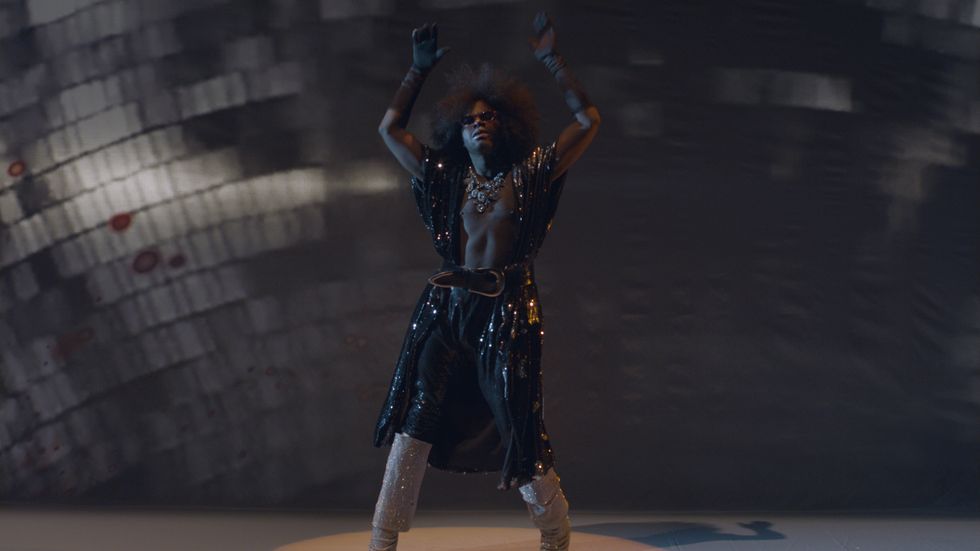Jaamil Olawale Kosoko’s Career Presents a Syllabus for Change
Jaamil Olawale Kosoko is a conundrum, a puzzle whose pieces must be mixed to match. It’s appropriate that Chameleon is the title of his most recent project. Like the old-world lizard of the same name, the Nigerian-American performance artist/poet/curator/educator changes colors—moods, modes—and shakes things up, right before your eyes. As an improviser, none of his performances are the same. His art finds its own logic as it travels a mysterious inner trajectory with episodes of grief and terror, wit and healing, sometimes wrapped around one another.
Angela Davis said about the films of Ava DuVernay, “It’s art that can begin to make us feel what we don’t necessarily yet understand.” That’s true for Kosoko’s major performance works—Chameleon (2020), Séancers (2017), #negrophobia (2015) and Black Male Revisited (2013). He uses voiceovers, spoken word, live soundscape, archival and live video projection, performance collaborators and, at the center, his own Black performing body, to reveal a selected, complex version of what he terms his “curated life.” His mirror reflects back on the spectator in ways that invite us to pause, ponder and reassess how we see what we see.

Chameleon Courtesy EMPAC
As Kosoko claims, “Not every story is a dance story. Sometimes you have to write it. Not every concept lends itself to the stage.” In Belgium, South Africa, Sweden, Switzerland, Germany, the Netherlands, Canada, the United Kingdom, Finland and Norway he’s performed full works and also shared his works-in-progress as movement-lecture-performances in museums, galleries, libraries and black-box spaces. His poems have appeared in a solo collection, Notes on an Urban Kill-Floor: Poems for Detroit (Old City Publishing), and in journals such as American Poetry Review and the Dunes Review.
Holding an MA in curatorial studies from Wesleyan University and writing essays on the subject, Kosoko has also provided his managerial savvy to events by emerging and established artists in the greater New York, New Jersey and Philadelphia areas. In addition, he makes films and podcasts to accompany or announce his performances. This spirit of trying various media to see what a particular story demands is part of what makes his work so compelling.
Kosoko belongs to a generation of diasporan performance artists whose concerns dig deeply into the sources of their angst and the mother lode of their identities: African; Caribbean; North American; peripheral; othered; authentic; essential—the unapologetic outliers. Divested of the need to play it safe, they are rooted in their own cultural entitlement that empowers them to pursue a millennial, Afro-futuristic course as movers, writers, thinkers, lecturers, producers—as multidimensional creatives. They are shape-shifting imaginers of extraordinary worlds, dredging up and leaving exposed past stereotypes and closeted ghosts, and transforming trauma into catharsis along the way.
Dana Michel (Canada), Kettly Noël (Haiti; Mali), Nia Love and Okwui Okpokwasili are fellow travelers on this road. Senior visual conceptual performance artists Lorraine O’Grady, William Pope.L and Sherman Fleming, as well as dancers Ishmael Houston-Jones and Bill T. Jones, are ancestors in this genre. Tim Miller, Holly Hughes and Karen Finley are lurking in the wings as seconds.
They all belong to the same aesthetic family tree, and Kosoko has created his own branch. He is the quintessential embodiment of James Baldwin’s assertion that “all art is a kind of confession, more or less oblique. All artists, if they are to survive, are forced, at last, to tell the whole story; to vomit the anguish up.”
Born in Detroit, Michigan, a hardscrabble home life exposed Kosoko to emotional and verbal trauma. He described it as “the theater of the house; the policing of gender, sexualities, behaviors.” Nevertheless, grassroots performance modes at social gatherings, parties, cookouts and just hanging out—so significant in African-American urban settings—were part of his upbringing.
It was not until he attended the Interlochen Arts Academy as a teenager that he was introduced to formal artistic training. He confesses that his two years there, from 1999 to 2001, changed his life. Accepted as a poetry major, he also studied writing and photography. Later, intense yoga training in retreats at the Kripalu Center for Yoga & Health was another lifesaver. Drawing upon his many talents, he created a particular mode of embodied performance art as a way to explore and untangle the grief of his early years.
The COVID-19 pandemic was the most recent terror/trap in the life of this Black male queer artist, but transforming to keep going was already part and parcel of his modus operandi. Deftly pivoting to virtual reality, Kosoko is making optimal use of digital platforms, including Discord (a gaming and communications interface) as well as Zoom, Instagram and the webinar function, allowing him to intersect his talents so that the poet/scholar seamlessly engages in the virtual performance space.
Last spring, he transformed the co-commissioned EMPAC, New York Live Arts and Wexner Center for the Arts premiere of Chameleon into a series of visual installments honoring Earth Day (April 22). In his own words, this experience helped him “listen to how the work wished to behave, transform, respond.” The performance morphed into “an act of digital protest and community interactive learning” and included conversations, readings, movement workshops and lecture-discussions.
For the fall semester 2020, he was engaged by the UCLA World Arts and Cultures/Dance department as the Alma Hawkins Visiting Chair—virtually, of course. He is also the recipient of a 2020–21 Wexner Center Artist Residency Award, for which he is creating “a second compilation of movement-based, visual choreopoems,” he says. He is one of a select cadre of artists to be awarded the coveted Pew Center for Arts & Heritage Fellowship for 2020.
Kosoko’s work is taking flight in an era when it seems the winds of change are finally acknowledging that Black Lives Matter—not as a catchphrase, but as specific and exceptional as the life and work of Jaamil Olawale Kosoko.



